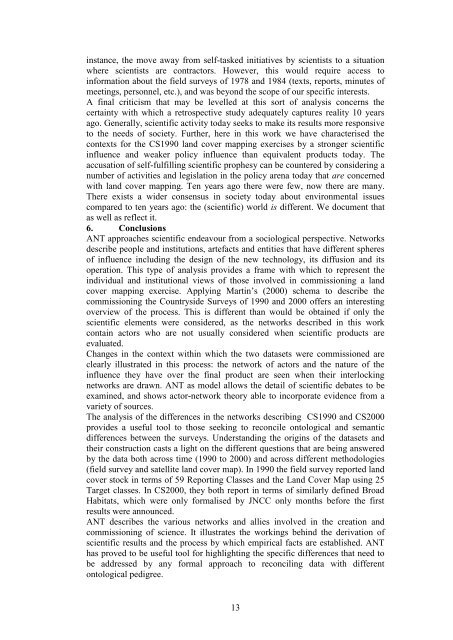Actor Network Theory - Leicester Research Archive - University of ...
Actor Network Theory - Leicester Research Archive - University of ...
Actor Network Theory - Leicester Research Archive - University of ...
Create successful ePaper yourself
Turn your PDF publications into a flip-book with our unique Google optimized e-Paper software.
instance, the move away from self-tasked initiatives by scientists to a situation<br />
where scientists are contractors. However, this would require access to<br />
information about the field surveys <strong>of</strong> 1978 and 1984 (texts, reports, minutes <strong>of</strong><br />
meetings, personnel, etc.), and was beyond the scope <strong>of</strong> our specific interests.<br />
A final criticism that may be levelled at this sort <strong>of</strong> analysis concerns the<br />
certainty with which a retrospective study adequately captures reality 10 years<br />
ago. Generally, scientific activity today seeks to make its results more responsive<br />
to the needs <strong>of</strong> society. Further, here in this work we have characterised the<br />
contexts for the CS1990 land cover mapping exercises by a stronger scientific<br />
influence and weaker policy influence than equivalent products today. The<br />
accusation <strong>of</strong> self-fulfilling scientific prophesy can be countered by considering a<br />
number <strong>of</strong> activities and legislation in the policy arena today that are concerned<br />
with land cover mapping. Ten years ago there were few, now there are many.<br />
There exists a wider consensus in society today about environmental issues<br />
compared to ten years ago: the (scientific) world is different. We document that<br />
as well as reflect it.<br />
6. Conclusions<br />
ANT approaches scientific endeavour from a sociological perspective. <strong>Network</strong>s<br />
describe people and institutions, artefacts and entities that have different spheres<br />
<strong>of</strong> influence including the design <strong>of</strong> the new technology, its diffusion and its<br />
operation. This type <strong>of</strong> analysis provides a frame with which to represent the<br />
individual and institutional views <strong>of</strong> those involved in commissioning a land<br />
cover mapping exercise. Applying Martin‘s (2000) schema to describe the<br />
commissioning the Countryside Surveys <strong>of</strong> 1990 and 2000 <strong>of</strong>fers an interesting<br />
overview <strong>of</strong> the process. This is different than would be obtained if only the<br />
scientific elements were considered, as the networks described in this work<br />
contain actors who are not usually considered when scientific products are<br />
evaluated.<br />
Changes in the context within which the two datasets were commissioned are<br />
clearly illustrated in this process: the network <strong>of</strong> actors and the nature <strong>of</strong> the<br />
influence they have over the final product are seen when their interlocking<br />
networks are drawn. ANT as model allows the detail <strong>of</strong> scientific debates to be<br />
examined, and shows actor-network theory able to incorporate evidence from a<br />
variety <strong>of</strong> sources.<br />
The analysis <strong>of</strong> the differences in the networks describing CS1990 and CS2000<br />
provides a useful tool to those seeking to reconcile ontological and semantic<br />
differences between the surveys. Understanding the origins <strong>of</strong> the datasets and<br />
their construction casts a light on the different questions that are being answered<br />
by the data both across time (1990 to 2000) and across different methodologies<br />
(field survey and satellite land cover map). In 1990 the field survey reported land<br />
cover stock in terms <strong>of</strong> 59 Reporting Classes and the Land Cover Map using 25<br />
Target classes. In CS2000, they both report in terms <strong>of</strong> similarly defined Broad<br />
Habitats, which were only formalised by JNCC only months before the first<br />
results were announced.<br />
ANT describes the various networks and allies involved in the creation and<br />
commissioning <strong>of</strong> science. It illustrates the workings behind the derivation <strong>of</strong><br />
scientific results and the process by which empirical facts are established. ANT<br />
has proved to be useful tool for highlighting the specific differences that need to<br />
be addressed by any formal approach to reconciling data with different<br />
ontological pedigree.<br />
13














